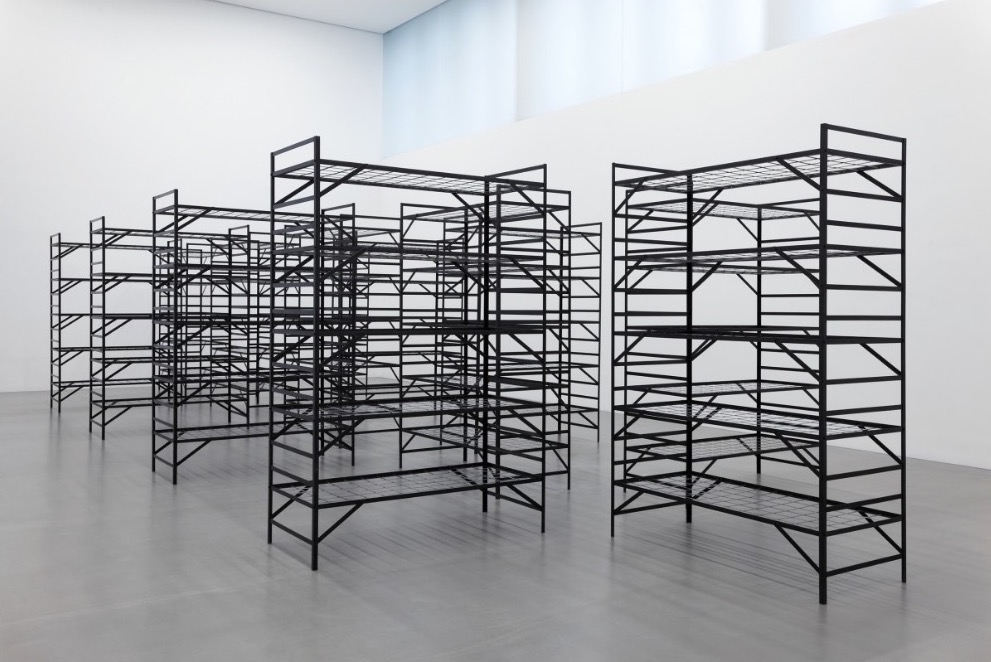White Cube presents an exhibition by Mona Hatoum. The first presentation of her work in London since Tate Modern in 2016, it includes new and recent installation, sculpture and works on paper.
Hatoum’s work reflects on subjects that arise from our current global condition, including systems of confinement, the architecture of surveillance and themes of mobility and conflict. Channelling the poetic charge and metaphoric resonance of a wide range of materials from steel, brick and concrete, to rubble, glass and human hair, in this exhibition she explores the elemental forms of the grid and the sphere, drawing on both the geometric rigour of Minimalist sculpture and the possibilities for its formal collapse.
In the major new installation Remains to be Seen (2019), heavy, industrial building materials are transformed into a light, suspended cube. Created from rows of steel rebar that are punctuated with what looks like chunks of concrete flooring, it hovers just above the ground in perfect vertical and horizontal alignment, as if a multi-story building has been reduced to the mere skeletal lines and indices of the original structure. Situated close-by, the work Orbital (2018) employs similar materials resonant of war and destruction, in the form of a globe created from lengths of bent rebar adorned with rough, textural lumps of aggregate rubble that appear like a series of planets rotating in orbit. Vernacular building materials are also used in A Pile of Bricks (2019) which, as its title suggests, consists of a stack of terracotta bricks arranged on a low, wooden trolley. A commonplace ensemble – similar bricks on trolleys can be found across building sites – it recalls a mobile architectural model, whose many holes mimic the windows of a large building such as an apartment or office block. Partially carved away and indented, as if the once flat facade has caved in from some kind of force, it remains in a state of tension, poised between its organised, geometric structure and the inference of destruction.
An exploration of the grid runs throughout the exhibition, present in works such as Hair Mesh (2013), a billowing curtain of woven grids of hair and Cells (2014), a stack of metal lockers – the kind typically used in factories or institutions – containing red, amorphous glass shapes, confined and compressed inside the rigid form. Glass also features in a new large-scale suspended installation, a mobile of the world map, whose continents are cut from delicate sheet-glass and hung from the ceiling by metal rods. Both pictorial and animated, its form is restless, a vision of a world dismembered. In other sculptures, Hatoum explores the basic form of the globe, manifested in various different textural materials. In Dark Matter (2019), for example, the globe is covered with a dense carpet of iron filings creating a soft and downy hair-like surface, whose endless, circuitous patterning suggests the coils of a digestive system with its undulating yards of compressed gut. A similar surface pattern covers the form of Inside Out (2019), this time smaller in scale and cast in bronze.
A new and expanded version of Hatoum’s iconic installation Quarters recreates the original size and formation of its first showing at Viafarini in Milan in 1996. Reduced, hard-edged and minimal in its sculptural language, an array of steel bunks, each with five individual ‘beds’, are arranged in cross formation. Offering limited space to navigate its form and dizzying views through its vertical and horizontal axes, the installation seems without beginning or end – it is restrictive, oppressive and claustrophobic. While Quarters makes reference to the architecture of municipal confinement, Hatoum explores the notion of home as a contested and politicised site in her large-scale, disquieting installation titled Remains of the Day (2016-18). A project first conceived for the 10thHiroshima Art Prize exhibition, it is here installed alongside two other sculptures or ‘rooms’ in the same series: distinct domestic settings that include a kitchen and a play area with children’s chairs, toy trucks and a cot. Burnt and charred, their ghostly remains are barely held together by a delicate wrapping of chicken wire. The whole ensemble appears like shadows of the solid objects they once were, locating the idea of ‘home’ not as a place of refuge and established order but as a site of upheaval, disorder and the uncanny.
| Duration | 12 September 2019 - 03 November 2019 |
| Times | Tuesday - Saturday 10am - 6pm Sunday 12pm - 6pm |
| Cost | Free |
| Venue | White Cube - Bermondsey Street |
| Address | 144 – 152 Bermondsey Street, London, SE1 3TQ |
| Contact | / enquiries@whitecube.com / http://whitecube.com/ |

